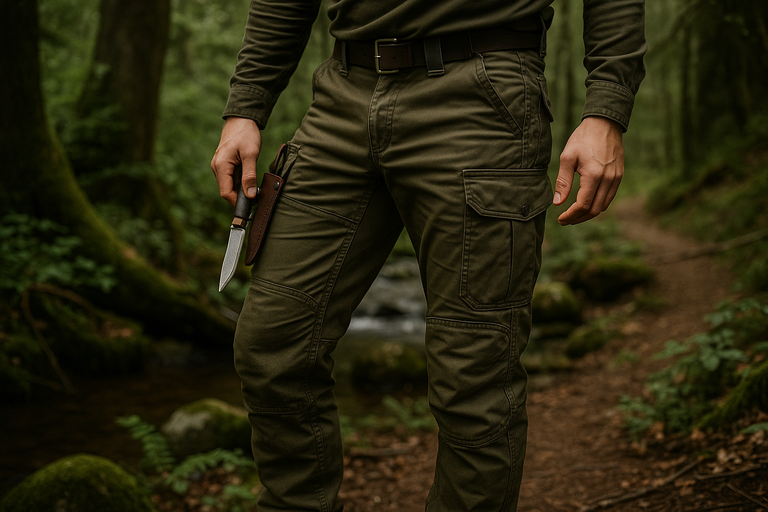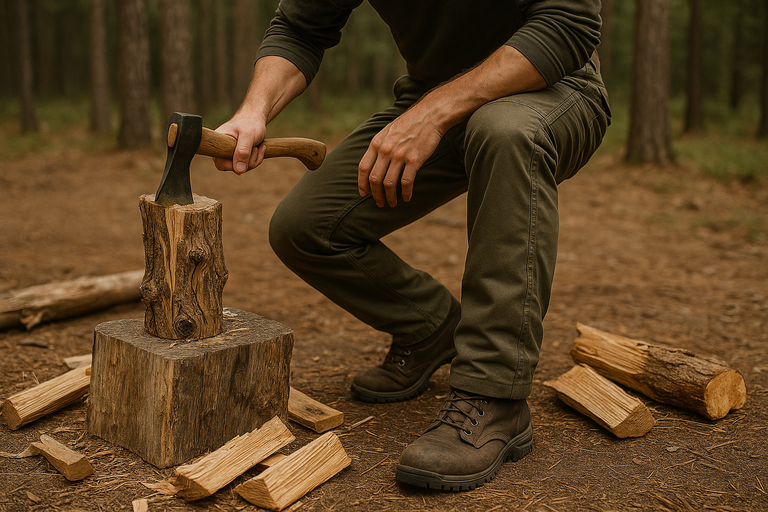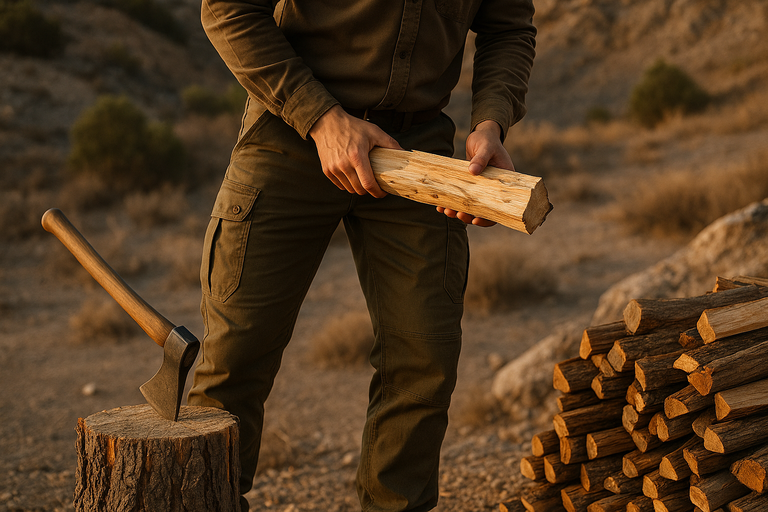When venturing into the wilderness, people often focus on gear like knives, backpacks, or fire starters. However, one of the most underrated essentials is your clothing—especially your bushcraft pants. These are not just regular outdoor trousers; they are designed specifically for durability, weather resistance, and maximum functionality in unpredictable environments.
For instance, imagine crouching by a fire, hiking through dense forest, or sitting on damp rocks. In each of these situations, your pants can either protect you or make you uncomfortable and vulnerable. Therefore, investing in a high-quality pair is one of the smartest decisions for any outdoor enthusiast.
Key Features to Look For in
Not all bushcraft pants are created equal. While appearance may seem important, performance is everything. For instance, reinforced knees and seat areas help prevent wear and tear during prolonged sitting or kneeling. In addition, articulated knees and gusseted crotches offer increased mobility, allowing you to climb, crouch, or scramble without resistance.
Bushcraft Survival Kit: Must-Have Items for Safety
Moreover, look for pants made from a durable fabric blend—such as poly-cotton ripstop—that resists tears and dries quickly. Integrated ventilation zippers, cargo pockets, and tool loops add function without bulk. Therefore, the more thought put into the design, the more useful they become in the field.

How Bushcraft Pants Improve Safety and Efficiency
Choosing the right bushcraft pants isn’t just about comfort—it can directly impact your safety. For instance, wearing the wrong materials in cold or wet conditions can result in hypothermia or severe discomfort. In contrast, breathable yet insulated pants help regulate your body temperature while allowing moisture to escape.
In addition, color and camo patterns can play a role depending on your environment. Earth tones blend well with forest surroundings, while brighter colors may be beneficial in high-traffic or hunting areas for visibility. Therefore, consider not only the build but also the context in which you’ll wear them.
Bushcraft Pants vs. Regular Outdoor Trousers
You might wonder: what sets bushcraft pants apart from ordinary hiking or tactical pants? The answer lies in design philosophy. While hiking pants often prioritize weight and packability, bushcraft pants are built for endurance and practical use. For instance, bushcraft pants frequently include fire-resistant fabrics or waxable cotton for waterproofing.
Bushcraft Classes: Rediscovering Nature Skills
In addition, they usually have better abrasion resistance and more pockets for gear. Some even include internal compartments for knives, folding saws, or ferro rods. Therefore, bushcraft pants are engineered for those who make fire, build shelters, and live off the land—not just walk through it.

Best Materials for Long-Lasting Bushcraft Pants
Material choice can make or break the effectiveness of your bushcraft pants. For instance, polyester blends are lightweight and quick-drying but may lack durability. Cotton is breathable but absorbs moisture. That’s why many premium bushcraft pants use a poly-cotton mix with ripstop weaving and optional wax coatings.
In addition, some include Kevlar or Cordura reinforcements in high-wear areas. These materials protect against thorns, sharp rocks, and even brief contact with fire. Therefore, choosing pants with thoughtfully selected fabrics increases both their lifespan and your comfort in harsh conditions.
Seasonal Considerations for Bushcraft Pants
Your bushcraft pants should match the seasons and environments you explore. For instance, in summer, lightweight and breathable fabrics with zippered vents offer relief in hot weather. In colder months, insulated or lined pants help retain heat without compromising mobility.
In addition, layering options are key. You may want to wear long johns beneath or waterproof overpants on top depending on the situation. Therefore, consider having at least two pairs tailored for summer and winter respectively. That way, you’re prepared no matter the season or setting.
Maintenance Tips for Durable Bushcraft Pants
Proper maintenance extends the life of your bushcraft pants significantly. For instance, avoid using harsh detergents or fabric softeners, which can weaken water-repellent coatings. Instead, wash them on a gentle cycle and air dry whenever possible.
In addition, some materials benefit from re-waxing or applying DWR (durable water repellent) treatments. Check for loose stitching, worn zippers, or fabric thinning in high-use areas. Therefore, regular inspection and maintenance keep your pants in top shape for many adventures to come.

Recommended Brands Known for Quality Bushcraft Pants
Several outdoor gear brands specialize in high-performance bushcraft pants. For instance, Fjällräven is renowned for its G-1000 fabric and customizable wax treatments. In addition, Helikon-Tex offers pants with a tactical design but practical bushcraft features like internal kneepad pockets and ventilation panels.
Why Wilderness Survival Skills Training Matters More Than Ever
Other respected names include Savotta, 5.11 Tactical, and even military surplus sources. Therefore, take the time to try different styles and fits—what works for one person may not work for another. The right pair can serve you reliably for years.
How to Test Bushcraft Pants Before Taking Them on a Trip
Before you rely on a new pair of bushcraft pants in the wild, it’s wise to test them in a controlled environment. For instance, wear them on short hikes, during weekend bushcraft practice, or even around the yard. Pay attention to comfort, breathability, and how well the pockets hold gear.
In addition, test their performance when wet. Sit on damp ground, walk through tall grass, or crawl under brush. Therefore, you can make adjustments, return them if needed, or supplement them with base layers. Testing before relying saves frustration—and possibly your safety.
How Bushcraft Pants Affect Your Movement and Endurance
The best bushcraft pants don’t just protect—they assist your movement. For instance, ergonomic paneling and stretch fabric allow you to climb steep terrain or squat without resistance. In addition, good pants reduce chafing, manage moisture, and improve airflow—all of which contribute to endurance over time.
Poor-fitting pants cause fatigue by forcing you to adjust them constantly. They might pinch at the waist, ride up at the ankle, or trap heat. Therefore, fit and function must go hand in hand. Try kneeling, climbing, and squatting before committing to a pair.
Practical Pockets and Their Role in Bushcraft Efficiency
Pocket placement can greatly enhance the utility of bushcraft pants. For instance, cargo pockets on the thighs keep essential gear accessible while sitting or kneeling. Internal dividers can hold knives, multitools, or small notebooks without shifting.
In addition, zippered pockets provide extra security for items like fire starters or maps. Therefore, when evaluating pants, don’t just count pockets—examine their size, position, and closure method. A well-designed pocket setup minimizes wasted motion and keeps your tools ready at all times.
Real-World Stories from Bushcrafters Who Swear by the Right Pants
Many seasoned outdoorspeople have stories about how their bushcraft pants made a real difference. For instance, some have spent nights kneeling beside a fire in freezing temperatures, relying on insulated, water-resistant pants to stay warm. Others crawled through briar patches without a single tear in their reinforced knees.
In addition, many bushcrafters note that the right pants reduce fatigue and increase confidence. When you don’t have to worry about snags, cold, or dampness, you focus more on shelter building, navigation, and firecraft. Therefore, pants aren’t just apparel—they’re part of your survival system.

